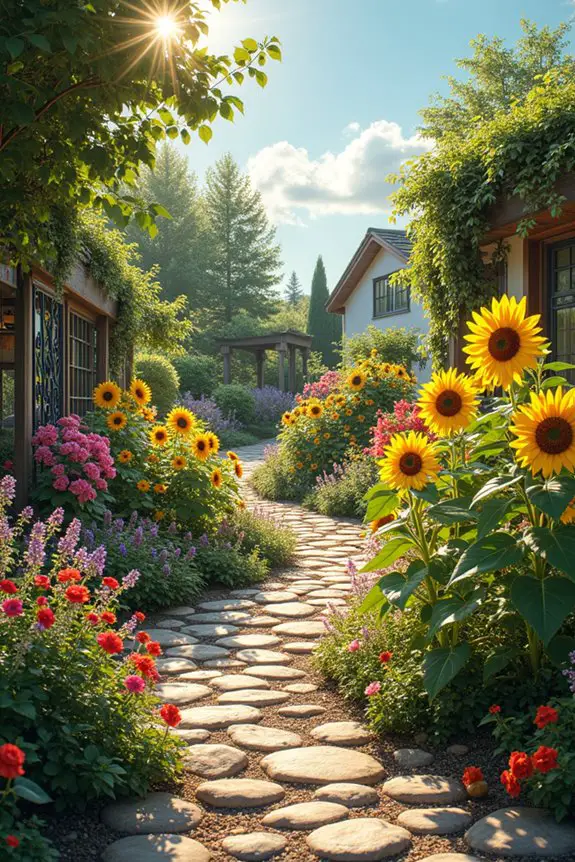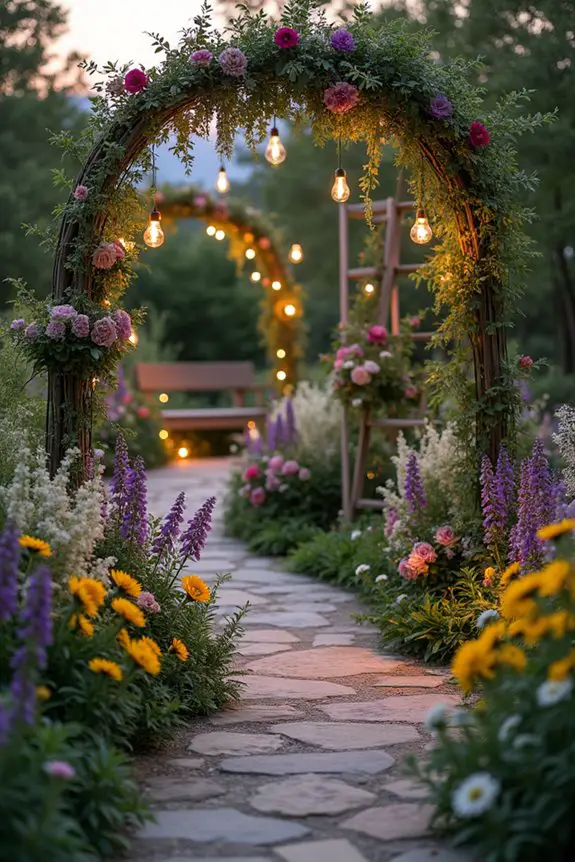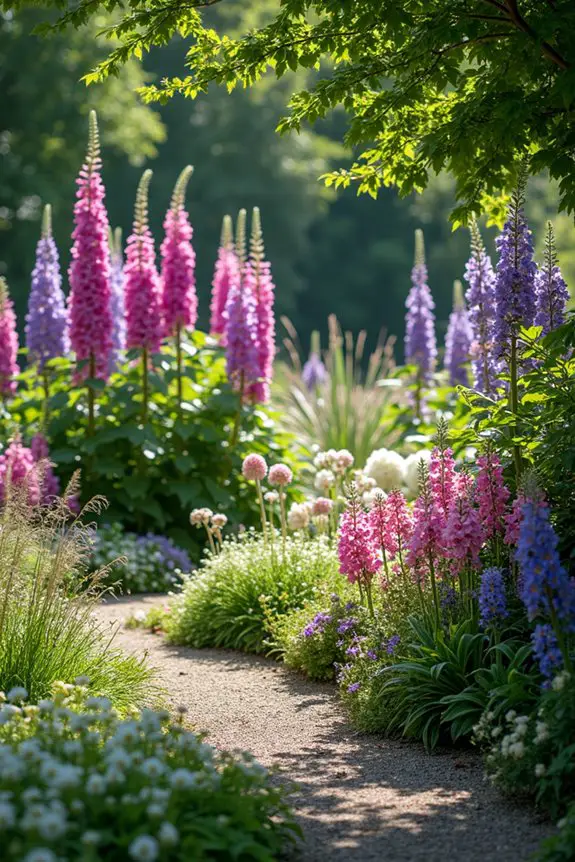So, you’re looking to jazz up your outdoor space with a stunning flower garden? You’ve come to the right place. Imagine stepping into vibrant perennial borders that change with the seasons or cozying up in a charming cottage garden filled with flowers and herbs. Feeling overwhelmed yet? Don’t worry; you’ll have a few laughs along the way, maybe even think of me trying to figure out which end of the shovel to use. Let’s explore some ideas that could transform your yard into a floral masterpiece.
Top 10 Flower Arranging Styles
When it comes to flower arranging, you’ve got a world of styles to choose from—ten of them, to be exact.
Ever tried your hand at a rustic bouquet? It’s like throwing a garden party in your living room. You can pluck blooms straight from your flower garden ideas, adding wildflowers and greenery for that effortless vibe.
A rustic bouquet brings the charm of a garden party indoors, filled with wildflowers and vibrant greenery for a relaxed, effortless vibe.
Or maybe you prefer a classic design, where order reigns supreme and every stem has its place.
Then there’s the modern look—think sleek lines and bold colors, perfect for a dinner party centerpiece.
Each style offers its own charm and lets your personality shine through.
1. Colorful Perennial Borders
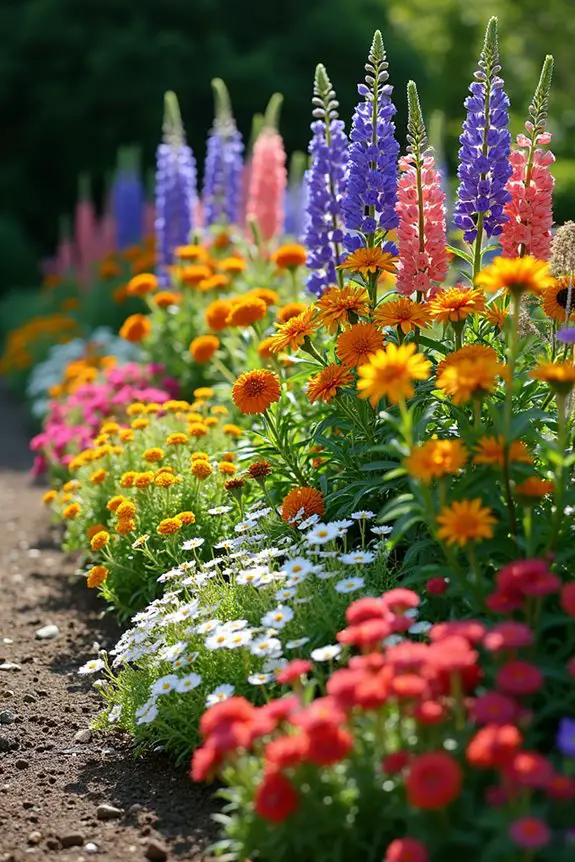
If you’re dreaming of a garden that looks like it just stepped out of a painting, then colorful perennial borders are the way to go. Not only do they add a burst of color and texture, which is great for the eyes, but they also provide structure and continuity throughout the seasons. It’s like giving your garden a backbone, allowing it to stand tall and proud all year long.
Let’s break down how to create your own colorful perennial border. First, you’ll want to decide on a sunny spot in your yard. Perennials thrive with plenty of sunlight, so picking a location that basks in golden rays will do your flowers wonders.
Next, consider the height and colors of the flowers you want to incorporate. Start with taller plants like delphiniums or sunflowers at the back, then layer smaller flowers like daylilies or daisies in the front. This creates a stunning vista that draws the eye and keeps your garden feeling lush.
Now, while you’re planning, don’t hesitate to think outside the box. Mix and match colors and shapes for a fun, playful vibe. Why not add some ornamental grasses for texture? They dance beautifully in the wind and add a little drama.
A foolproof tip? Choose plants that bloom at different times for color all season long. Imagine stepping into your yard and admiring pops of purple in the spring, followed by cheerful yellows and oranges all summer long. It’s like your garden is putting on a show just for you. Additionally, incorporating UV grow lights can help ensure optimal plant health and growth in your colorful perennial borders. To ensure that your plants receive the best environment, consider using versatile potting soil for healthy roots.
Once you’ve selected your flowers, it’s time to prep the soil. Loosen it up with a garden fork, and add some compost for that magical nutrient boost. Trust me, your plants will appreciate it—like giving them a cozy blanket to snuggle into.
Plant them according to their spacing needs, and don’t be afraid to stay a little longer in the garden, admiring your handiwork. And water them lovingly as they settle in. You’ll feel like a garden parent.
While you watch your border bloom, don’t forget to sprinkle in maintenance like deadheading and weeding. Keeping things tidy won’t only keep your garden looking sharp, but it’ll also encourage your flowers to keep blooming, creating that ongoing vibrancy you crave.
And remind yourself that it’s a journey — some flowers might flop, but that’s just nature’s way of keeping us humble, right? So, grab your gloves and dig in; your colorful perennial border awaits, ready to turn your garden into a veritable work of art.
2. Cottage Garden Charm

There’s something undeniably enchanting about a cottage garden—it’s like stepping into a whimsical storybook. With its effortless charm, this style invites you to take a moment, breathe deeply, and embrace the beauty of nature. It’s functional too! A cottage garden can provide a steady supply of flowers, herbs, and even vegetables, all while exuding a cozy, inviting vibe that welcomes both you and any wandering guests.
To start your own cottage garden, think about a mix of flowers, herbs, and even a few veggies, all packed into a more casual layout rather than the neat rows of traditional gardens. Imagine colorful blooms spilling over from every corner, with pops of height from tall foxgloves and billowing blooms of hollyhocks beckoning for attention.
To get that quintessential cottage look, plant in clusters, allowing the plants to intermingle and create a tapestry of color and texture. There’s beauty in imperfection, so don’t fret about every bloom being perfectly lined up.
A great tip is to incorporate a variety of plant heights and types—think of it as layering a delicious cake. Start with some taller plants in the back, medium ones in the middle, and ground-hugging varieties at the front, creating a stunning, inviting presence. Pollinator-friendly flowers like lavender and echinacea can take the stage while making your garden a buzzing hotspot for bees and butterflies.
And have you considered planting some herbs? Not only do they smell divine, but they’ll also come in handy for your culinary experiments. Imagine snipping fresh basil for your pasta or fluffy mint for invigorating tea on a hot day—yes, please.
Soil prep is essential. Enrich your garden bed with a generous amount of compost to make your plants feel pampered. Picture them winking at you as they sip up all that goodness from the earth. You don’t have to have a green thumb—gardening is as much about experimenting (and maybe a little praying) as it’s about knowledge. Additionally, incorporating a glass plant propagation station can help you propagate new plants to enhance your gardening experience.
Watering your plants will require some time each week, but consider it a good excuse to pause and enjoy the beauty you’ve created.
Maintenance can be as laid-back as the style itself. A little weeding here and there, deadheading spent blooms to encourage more flowering, and the occasional sneaky prune will keep your garden in tip-top shape.
I like to think of this whole process as an art form and a loving journey. Sure, not every plant will thrive, but those that do will bring you the sweetest satisfaction.
3. Zen-Inspired Rock Gardens
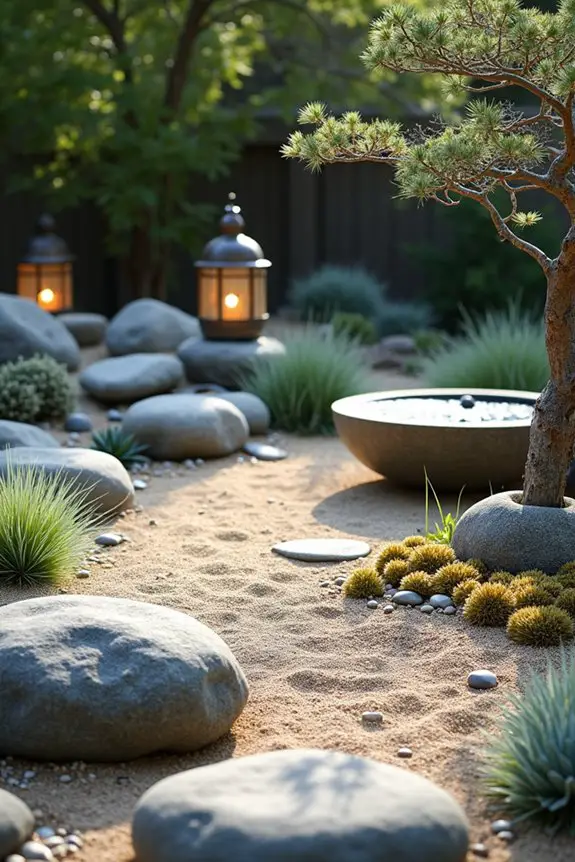
Imagine stepping into a serene oasis right in your backyard—a Zen-inspired rock garden does just that. With its minimalist look, interesting textures, and soothing vibes, this garden style offers a space for reflection, meditation, and peace. Plus, it’s a fantastic way to incorporate both functionality and aesthetics, using natural materials like stones and gravel which require less water and maintenance than traditional gardens. Adding worm castings to your garden can significantly boost the soil quality, enhancing plant growth.
To create your own Zen garden, you’ll want to start by picking the perfect spot—somewhere that gets a good amount of sunlight but also offers a quiet corner for relaxation. Next, gather your materials: a variety of rocks, gravel, sand, and some hardy plants. Think of plants that thrive in less soil, like succulents, ornamental grasses, or even some cute little bonsais, since they add an elemental touch without overcrowding your space. If I attempted to grow one of those fuzzy little cacti, my cats would declare it as a new toy, so maybe consider cat-proof options.
Once the location is established, it’s time for layout. Use larger stones as focal points, arranging them to guide the eye and create a sense of flow. Lay down sand or gravel to fill in the gaps, allowing for easy raking into pleasing patterns—think of it like creating your own canvas. The repetitive action of raking the gravel can be oh-so-therapeutic, like a mini spa day for your spirit.
Be sure to keep the design simple; less truly is more here. This isn’t the place for a chaotic explosion of colors; instead, aim for soothing earth tones interspersed with lush textures.
Oh, and don’t forget about the details. Adding elements like a tiny water feature or a simple stone bench can create cozy nooks for reading or sipping tea. Picture yourself nestled among the rocks, the soft sound of water trickling nearby, as you ponder life’s greatest mysteries—or maybe just what’s for dinner. Plus, incorporating a decorative element like a metal watering can can enhance the aesthetic appeal of your garden.
If you want to take it up a notch, consider incorporating a few carefully placed lanterns for nighttime ambiance. Just be cautious not to trip over them on your nightly stroll, trust me, that’s a lesson learned the hard way.
Finally, maintenance is honestly a breeze. You’ll just need that occasional re-rake and maybe some weeding if a renegade plant tries to crash the party. As you care for your rock garden, think of it as a journey, not a destination. Each time you tend to it, you’ll find peace and a moment to breathe in the midst of your busy life.
4. Wildflower Meadow Mixing

Creating a wildflower meadow in your garden isn’t just a gorgeous visual feast—it’s also a vibrant way to attract butterflies, bees, and other pollinators. Imagine stepping outside to the sight of waving blossoms and hearing the joyful buzz of busy insects as they flit from flower to flower. It’s like having a mini paradise that nourishes both your soul and the environment.
So, how do you make this beautiful meadow a reality? First, you’ll want to choose the right spot in your yard. A sunny area is best since wildflowers thrive in bright light—sunbathers are their kind of besties. Clear the area of any grass or weeds, and don’t be shy, get in there and dig a bit if you need to. It’s a workout!
Once you’ve cleaned up, you can prepare the soil by loosening it up with a rake. Think of it as fluffing a cake batter—light and airy is the goal.
Next comes the fun part: selecting your wildflower seeds. Go for a mix that will bloom at different times throughout the season; it’s kind of like layering flavors in a great dish. Look for varieties that are native to your region because they’re more likely to thrive and bring local wildlife to your yard. Poppies, daisies, and black-eyed Susans are a few delightful options.
If you’re feeling adventurous, you might even throw in some quirky blooms, like globe thistles—talk about a conversation starter!
When it’s time to sow your seeds, scatter them evenly across the soil. A little tip? Instead of just tossing them haphazardly, mix them with some sand to help you see where they fall. It might be the best gardening tip since sliced bread.
After sowing, lightly press the seeds into the soil—similar to pushing down cookies on a baking sheet, just enough to make sure they stay snug but don’t disappear completely.
Now, water your budding meadow gently. Not too much; you don’t want to create a mudslide. Keep the soil moist, especially during those dry days, because those little seeds are counting on you.
And then, patience, my friend. It might feel like waiting for a soufflé to rise, but trust the process; soon enough, you’ll be requesting wildflower arrangements from your own backyard.
Just a few weeks down the road, you’ll see those bright blooms start to emerge. When they do, resist the urge to pluck and trim too much; let them thrive in their natural beauty. Remember, wildflowers aren’t the prim and proper cousins of your regular garden flowers. They thrive on the messy chaos of nature, and the beauty is in their wildness.
And here’s a pro tip: don’t worry too much about perfection. Like my baking escapades, they may not always turn out exactly as planned, but hey, those irregularities often add character.
As the seasons change, your wildflower meadow will transform too, just like you might sprinkle a different spice into a familiar recipe.
5. Shade Garden Wonders
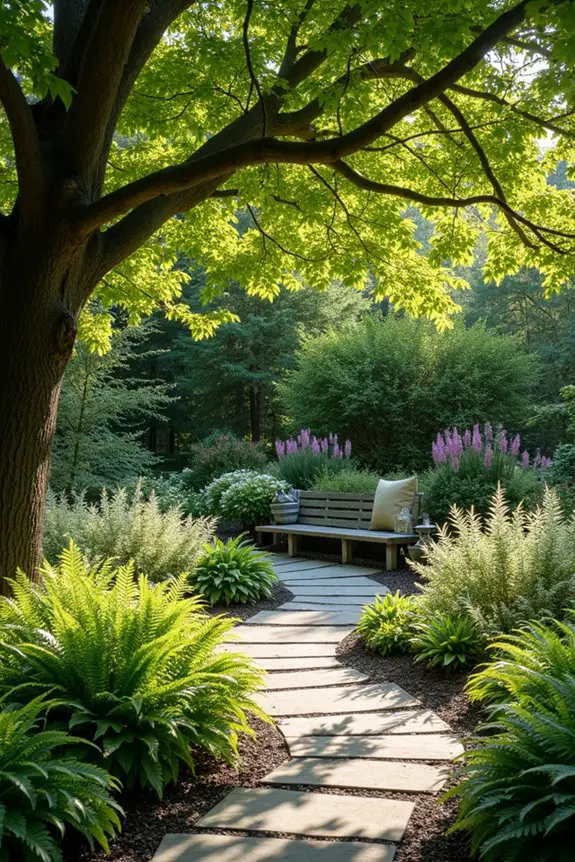
Creating a shade garden may just be one of the best-kept secrets in the gardening world. Not only does it beautifully transform those dimly lit corners of your yard, but it also provides a peaceful retreat that feels invigorating and cool during those hot days. Imagine stepping into a serene oasis, where dappled sunlight filters through the leaves, and you can hear the soft rustle of the breeze. Doesn’t that sound like bliss?
So, how do you get started with your very own shade garden? First things first—identify the shady spots in your yard. Look for areas under mature trees, around your house, or even under a gazebo. These are your blank canvases.
Now, it can be tempting to throw any plant into the shade and call it a day, but that could lead to a sad little green graveyard. Instead, you’ll want to choose plants that genuinely thrive in low light. Ferns, hostas, and astilbes are great choices, but don’t forget the lovely bleeding hearts or the enchanting toad lilies that dazzle with their quirky blooms. Each plant contributes its own magic to your shady sanctuary.
Once you’ve scoped out the plants, get to work on prepping the soil. Clear out any pesky weeds—you know, the ones that sprout up like they own the place. Loosen the soil a bit, using a shovel or a spade. If your soil is heavy clay, consider mixing in some compost to give it that fluffy texture—like giving it a spa day.
A nutrient-rich mix won’t only support your plants but also help retain moisture, which is super important in shady areas.
Now, plant those beauties. Give each one enough space to stretch out its roots and grow to its full potential. It’s like setting up a cozy dinner party; nobody likes to feel cramped, right? As you plant, think about layering. Tall plants can go in the back, with shorter ones up front—this creates depth and interest.
A little visual variety makes the scene pop, just like a well-styled plate of food garnished to perfection.
As you nurture your garden, don’t forget about the importance of mulch. Spread a layer around your plants to keep the moisture in, suppress weeds, and give that fresh garden smell. After all, who doesn’t love a good earthy scent wafting through the air?
Water the garden regularly, but don’t drown your newly planted babies; too much moisture can invite unwanted pests or diseases.
And here’s a little pro tip: consider adding some seating for those moments you want to just sit back and enjoy your handiwork. A little bench or a couple of chairs tucked away in the shade can create a perfect retreat for yourself, a friend, or even that cute neighbor you’ve been trying to find an excuse to chat with—just sayin’.
Before you know it, you’ll have a luxurious secret hideaway filled with lush foliage and gentle blooms, all in a space that was once forgotten.
And when the sun gets a bit too hot? You’ll be grateful for that tranquil patch of shade you transformed. So go on, dig in, and let the magic of a shade garden work its wonders.
6. Fragrant Herb Garden Ideas

Have you ever stepped into a garden and been greeted by the delightful aroma of fresh herbs? It’s like stepping into your favorite Italian restaurant, but this time, it’s in your own backyard. Creating a fragrant herb garden not only enhances your cooking but also adds a burst of life and scent to your outdoor space. Imagine snipping off fresh basil for your pasta or rubbing rosemary on your hands while you prepare dinner. Every time you walk by, the air fills with deliciousness. It’s a magical mix of functionality and style!
To get started on your fragrant herb garden, choose a sunny spot—herbs love their sunshine, so think of it like giving them a warm hug every day. You can opt for a simple raised bed or some cute pots if space is tight. Just remember: each herb has its own vibe, so mix it up to create a sensory symphony.
Consider planting basil, mint, thyme, and oregano. These little wonders not only taste amazing, but they also smell heavenly, each bringing its own charm to the table. And don’t forget about cilantro; people seem to either love it or hate it, but for those who adore it, it’s a must-have.
Now, let’s talk about soil. It’s kind of like the comfy mattress for your plants—firm, well-drained, and rich in nutrients. You’ll want to use a mix of potting soil and compost. Trust me, it’s like giving your herbs a five-star feed.
When planting, give each herb enough space; mint can be a tad greedy if it feels crowded, so plan wisely. Picture a dinner party where everyone has a cozy spot—no elbow bumping allowed.
As your herbs start to grow, it’s vital to keep them from feeling thirsty. A regular watering schedule works wonders, but don’t overdo it; herbs prefer a slight dryness between waterings. Think of it as letting them sip on a revitalizing drink rather than chugging an entire bottle.
During watering, remember to talk to them, because, who knows? Maybe your conversation will help them grow even better. Just don’t get too carried away; lawn chairs and sunglasses aren’t required for this!
Finally, give your fragrant garden a pop of personality. Consider adding decorative markers for each herb, so you don’t accidentally snip your cousin’s prized plant while thinking it’s the basil. Oh, the family drama that could unfold.
To really up the ante, try planting edible flowers—like nasturtiums or pansies—amongst your herbs for an added splash of color. Not only do they look stunning, but they can also elevate your dishes into culinary masterpieces.
Creating a fragrant herb garden works wonders for your kitchen and boosts your outdoor ambiance. You’ll enjoy the freshness every time you step outside. Just keep the garden thriving, and you might find that cooking becomes your new favorite pastime. So, grab your gardening gloves, and let’s get planting!
7. Succulent and Cacti Combinations
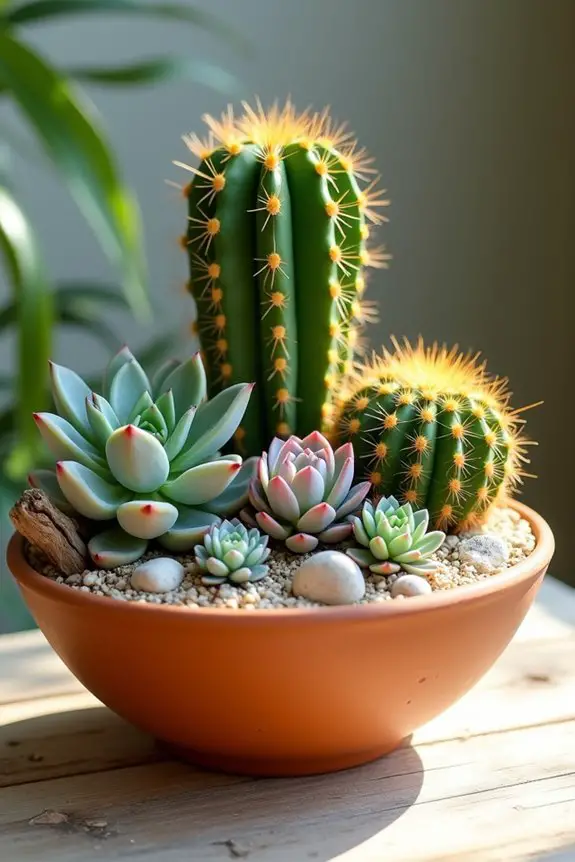
Ah, succulents and cacti—the perfect duo for adding a touch of earthy charm to your home or garden. Not only do these plants require minimal care, making them ideal for busy folks, but they also bring a quirky style to any space. Think of them as the cool kids at the plant party—tough, resilient, and oh-so-stylish.
So, how do you create a lively succulent and cacti combination? First, gather your plant pals. Mix and match a variety of shapes, sizes, and colors for an eye-catching display. For example, consider pairing a tall, spiky cactus with a round, plump succulent. It’s like pairing a classy cocktail dress with chic sneakers—unexpected yet delightful.
Remember to choose plants with similar water needs; most succulents prefer infrequent watering, while cacti can go even longer between sips. Trust me, nobody wants a thirsty plant meltdown.
Next up, think about your planters. Do you want them to share a pot, or would they thrive individually? If you choose a shared container, make sure it’s wide and shallow—kind of like a collective lounge chair at the beach. You want ample space for roots and good drainage. A pot with drainage holes is a must for success; nobody likes sitting in a puddle, right? You could even line the bottom with pebbles to keep things crisp and fresh.
Once you’ve got your plants and potting situation sorted, it’s time to have a little fun with arrangement. Start with your tallest plant in the back (or center, if it’s a round pot) and work your way down to the smaller ones in front. This staggered height creates depth and makes your display look more dynamic. Plus, it gives each plant its spotlight moment—because honestly, who doesn’t enjoy a little attention now and then?
When it comes to soil, think of it as a cozy blanket for your plants. Use a well-draining cactus mix or create your own by blending regular potting soil with sand and small stones. This blends texture and keeps everything airy. It’s like giving your cacti the beach holiday they didn’t ask for!
Now, while we’re cultivating a mini desert paradise, don’t forget the personality! Add decorative stones, a bit of driftwood, or even some colorful sand to your arrangement. These little extras not only look great but can really tie your theme together. Who knew a mischievous little succulent could have such character with just a splash of bling?
Finally, remember to give your plant buddies some love, but not too much. Water them every couple of weeks—you’ll want the soil to dry out between drinks, just like the well-meaning friend who’s always asking if you want a top-off at dinner. Regularly check for pests and dust, especially if they’re basking in the sunlight. If you see any creepy-crawlies, just wave goodbye.
With their low maintenance, these plants should bring you joy without the fuss.
In the end, combining succulents and cacti creates a stylish and serene corner in your space. So, roll up those sleeves, grab your plants, and let your green thumb shine! What’ve you got to lose besides a bit of elbow grease and a whole lot of joy?
8. Vertical Garden Innovations
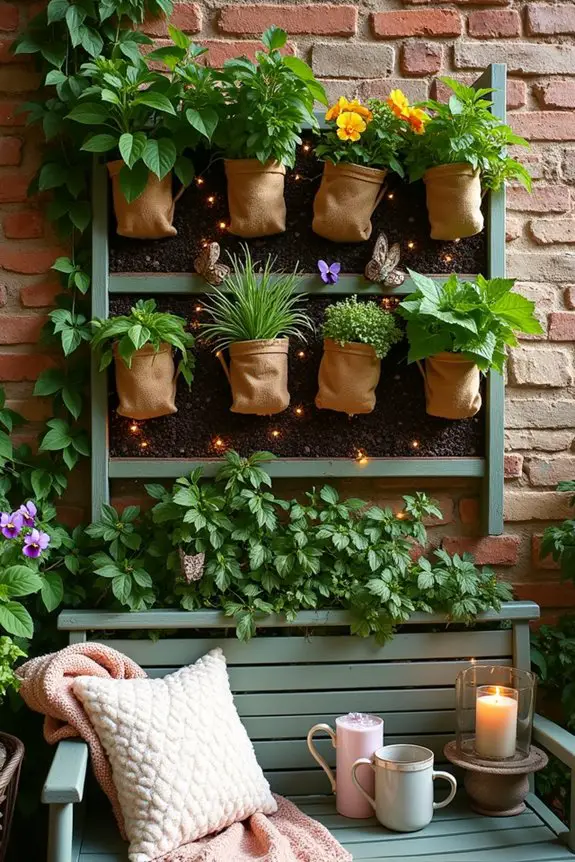
If you’re looking to spice up your garden space without taking up too much room, vertical gardens are the way to go. They’re practical, chic, and can transform a plain wall into a vibrant canvas of greenery. Plus, this innovative approach creates a unique focal point that not only beautifies your home but also maximizes your space, especially in urban environments where every inch counts.
To start your vertical garden journey, pick a wall that gets adequate sunlight—think of it as the MVP of your garden setup. You might want to use a trellis, wall planter, or even create a pocket garden with fabric bags that can hold your plants vertically. Just like hanging up your favorite art picture, placing your garden against a wall adds an artistic flair to your outdoor (or indoor) space.
When it comes to selecting plants, choose a mix that thrives in your local climate. Herbs, flowers, and leafy greens are all great options. I once planted a vertical herb garden with basil, mint, and thyme that had me feeling like a culinary wizard every time I’d whip up dinner. The smell alone was enchanting!
As for planting, position the larger plants at the bottom and work your way up to smaller ones—kind of like stacking a lovely, leafy cake. This way, they’ll get enough sunlight and provide a nice cascading effect.
Now, let’s talk about soil—you’re going to need a lightweight potting mix that retains moisture but also drains well. Nobody wants a soggy situation here; think of it like wearing the wrong shoes on a rainy day, an absolute disaster. You might even throw in some water-retaining crystals if you’re feeling fancy, which can save you from watering woes on busy days.
When it comes to watering, consistency is key. A drip irrigation system can be a lifesaver, providing a steady supply without drowning anyone in the process. Plus, it’s like having a little garden butler, taking care of your plants while you binge-watch your favorite show on the couch.
Here’s a little bonus tip: don’t forget to add some decorative elements to your vertical garden. You can hang fairy lights for a magical nighttime ambiance or attach small decorative features like butterflies or succulents to mix things up a bit.
It really helps to give your garden that “wow” factor—like adding sprinkles to your ice cream sundae. So, go on, turn that boring wall into a vertical paradise that not only looks good but also feels inviting. You’ll be sipping your morning coffee while admiring your green masterpiece in no time.
9. Tropical Flower Oasis Design

Creating a tropical flower oasis is a fantastic way to transport your backyard into a vacation paradise. It not only adds vibrant colors and exotic fragrances but also sets a relaxed, vacation-like mood that can elevate any outdoor space. Imagine hosting friends for a backyard barbecue or sipping lemonade while being surrounded by lush greenery and bright blooms—now that’s life!
To start, choose a spot in your garden that gets ample sunlight because, let’s be real, tropical plants are like sun-hungry kids at the beach—they thrive in bright light. Begin by selecting an array of tropical flowers such as hibiscus, bird of paradise, plumeria, or even some cheerful bougainvillea. These aren’t just pretty faces; they’re all about that high-impact color, with vibrant pinks, reds, and yellows that can turn any space into a magical retreat.
Choose a sunny spot for your tropical blooms like hibiscus and bird of paradise, and watch your garden explode with vibrant colors!
When planting, think layers. Position taller plants at the back or center and shorter ones towards the front. It’s kind of like creating a multi-tiered cake, with each layer showing off its unique flavor. You can sprinkle in some lush ferns or broad-leaved plants to create that tropical jungle vibe. Just remember, spacing is key—allow enough room for each plant to spread out and show off its glorious blooms.
It’s also essential to create texture and interest with different leaf shapes and sizes. Mixing in some tropical foliage can really give your oasis that “wow” factor. You might try adding a few palm or banana plants for that authentic tropical sensation. Just imagine how glamorous your backyard would look—the neighbors might just mistake it for a five-star resort.
Watering is another critical step; tropical plants love humidity. Aim to keep the soil consistently moist—like trying to maintain your favorite avocado’s ripeness. A well-draining potting mix can do wonders, and if you’re feeling generous, consider mulching with coconut coir or shredded bark for that extra boost of moisture.
I once forgot to water my tropical plants for a few days (life got busy, you know how it goes), and let’s just say my hopes of a tropical paradise quickly turned into a sad desert scene. Water regularly, and your plants will reward you with a flourishing display.
To elevate the space, don’t hesitate to add decorative touches like colorful garden sculptures or fairy lights for those summer evenings. A cozy seating area surrounded by your tropical blooms makes for a perfect reading nook or little hideaway, where you can dream of sandy beaches without ever leaving home.
10. Garden Maintenance Strategies
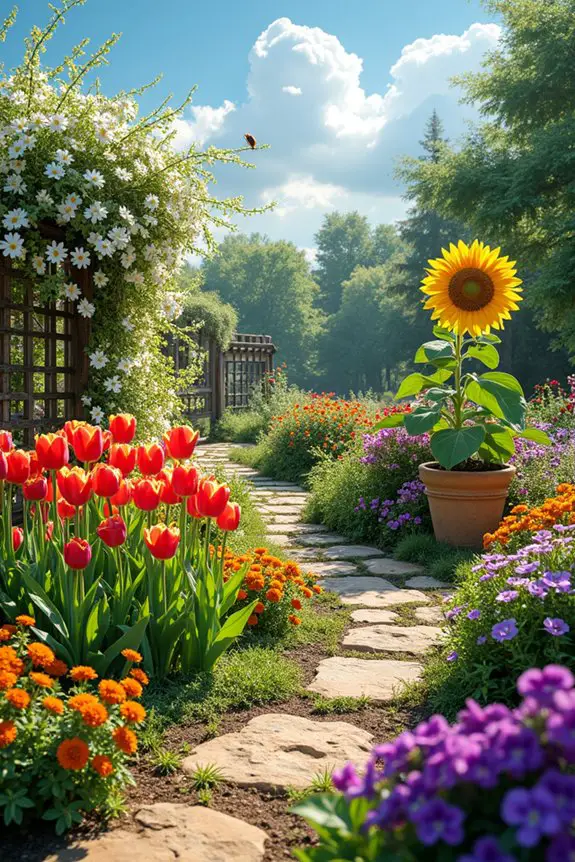
Maintaining a vibrant garden is like keeping a flourishing friendship alive. It requires regular attention, a little bit of nurturing, and the occasional tidy-up. Think of it as giving your plants the love they need, so they bloom and thrive as much as that cherished friendship. Who doesn’t want a garden that reflects joy and a bit of well-cared-for chaos, right?
Start by creating a maintenance schedule—this is your garden’s “to-do” list, so to speak. Pick a day each week to check on your plants, water them, and remove any pesky weeds. It’s like taking your dog for a walk; it’s essential but can sometimes feel like a chore. You can keep it fun by blasting your favorite tunes on your phone while you work.
I may or may not have danced with a trowel in hand during one particularly energetic weeding session. Weeding can be therapeutic after all, just keep an eye out for those sneaky ants; they can be more intrusive than they seem.
Next, don’t forget about pruning. Yes, it sounds a little scary, but think of it as giving your plants a haircut. Trim away dead or overgrown branches to keep plants healthy and promote new growth. Just avoid the temptation to go all Edward Scissorhands on them, as doing too much at once can stress your plants out. A couple of snips here and there will do the trick and have your plants looking sharp and lively—sort of like a weekend makeover.
Now, let’s chat about fertilizing. Whether you go for organic options or synthetic ones, a good fertilizing schedule can give your plants the nutrients they need to thrive. I used to think that plants were like the magical creatures who could survive on sunlight alone, but boy was I wrong.
Give them a boost every few months, especially during the growing season. Your plants will thank you with brighter colors and bigger blooms. Just remember, while your plants mightn’t need lattes or pizza like you do, they sure appreciate a good nutrient fix.
Lastly, pay attention to pests—those little invaders can turn your garden from paradise to pest-astrophe quicker than you can say “aphids.” Use natural insecticides or introduce friendly garden bugs like ladybugs that’ll feast on those pests.
I once attempted to make my own bug spray and ended up creating a concoction that smelled so bad it made my neighbor’s cat faint. Sometimes, nature knows best; partnering up with good bugs is often the way to go—and it makes you feel like a garden superhero.
Seasonal Planting Calendar
Knowing what to plant and when can feel like a dizzying puzzle, but it doesn’t have to be. Think of the seasonal planting calendar as your garden’s recipe book.
In spring, you can plunge into planting vibrant zinnias and cheerful daisies. As summer heats up, consider adding cosmos or marigolds to the mix.
Fall’s the time for those gorgeous chrysanthemums; they’re like the cozy sweater of your garden.
And winter? It’s perfect for planning; sketch out your dreams and make lists, because come spring, you’ll be ready to roll.
Trust me, I once forgot about my tulip bulbs and they became an unforgettable surprise.

